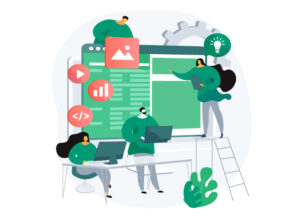Your products are what make or break your brand. Whether it is a software product or any other type, your products will always be at the core for which your customers will keep coming back to your site. And this entire process of bringing a new product to life starting from Idea Generation to Product Launch is known as PDLC or Product Development Life Cycle. Efficient implementation of PDLC ensures effective management of software projects.
As a Senior Software Developer and Project Manager for a leading software company in Bangladesh, Dcastalia Limited, I have personally worked through the product development life cycle a number of times, and that’s what I'll be talking about here! Much like a butterfly that goes through various stages of growth, the development of a software product goes through a similar process. PDLC is a framework that outlines this process by dividing it into small stages.
In this blog post, I'll dive deeper into what PDLC actually means and why project management is particularly important in software development, along with exploring its different stages. But a quick clarification before I dive in: the terms PDLC and SDLC often get interchanged, even though they refer to two completely different concepts. While PDLC covers the entire process of launching a new product including software products, the Software Development Life Cycle, or SDLC, is a subset of PDLC that focuses only on the development of software products. So let's get started now!
Checklist
Understanding PDLC in Software Development
What is Product Development Life Cycle?

Think of product development as a journey, and the Product Development Life Cycle as its roadmap. Just like a roadmap lays out all the different routes and directions possible, PDLC outlines the stages involved in developing a product in a similar manner.
PDLC attempts to create the best framework for all the stages that go into product development for a specific product. And this framework is extremely helpful for navigating the complexities of the product development process as a whole and delivering your product on time successfully.
What is PDLC in Software Development?
If you tried googling the term Product Development Life Cycle, then you must have come across the term SDLC or Software Development Life Cycle as well. As clarified earlier, SDLC and PDLC are completely different concepts.
SDLC is a structured flow of stages, from planning to maintenance, for delivering software. While PDLC is the structured flow of stages that covers the entire process of developing a product. In software development, PDLC is like a chef crafting a new recipe, carefully selecting the ingredients, and testing different combinations, until creating the perfect dish. Or in this case, a successful product!
While implementation of the complete checklist of the Software Development Life Cycle involves the technical aspects of software development thoroughly, PDLC specifically focuses mainly on implementing all things related to product development – defining requirements, designing, developing, testing, and deploying the end software.
Anatomy of a Product Development Life Cycle
There are a few different ways to categorize the steps in the Product Development Life Cycle. But I am here to make this easier for you right? Largest enterprise solution providers in Bangladesh, as well as the globally prominent software companies has tried out different combinations of phases and stages to find the most effective and efficient framework for developing software, I present to you how I distribute the entire Product Development Life Cycle into 9 small steps:
Idea Infusion
As a project manager, the Idea Infusion stage is personally one of my favorite phases in the Product Development Life Cycle. It’s like brainstorming new recipes in the kitchen, where we identify an issue and start thinking about how to solve it with a new product. This first phase of PDLC is critical because it sets the overall direction for the product development process. During this stage –
i) we gather input from various stakeholders
ii) generate creative ideas that will resonate with end-users
Outcome: By the end of the Idea Infusion stage, I aim to have a solid concept for the software that aligns with the aims and goals of the organization.
Market Research
The Marketing Analysis stage is like a compass that guides the direction of the entire product development process. It’s the most important stage because it ensures that my product idea is unique and beneficial for the users. At this stage, the entire team conduct –
i) market research to determine the feasibility of the product
ii) the feasibility study includes researching the target market, identifying potential customers, and determining the size of the market
Outcome: Through this process, I determine whether the idea of the software is worth investing my time and resources into, or not.
Concept Development
In the Concept Development stage of the PDLC, my team and I put our detective hats together, much like Sherlock and Watson, and try to find out what makes our product unique. We dive deep into the product’s features, benefits, and target market in a detailed manner. This phase is all about –
i) Refining our idea about the product
ii) identifying potential roadblocks to make sure the viability of the product
iii) ensuring the feasibility to bring the product into the market
Outcome: The output of this phase is a detailed Concept Document that outlines my vision for the software product, which further lays the foundation for the Design Document Specification (DDS).
Business Analysis
Perhaps one of the most crucial factors of software development projects is the Business Analysis phase. The team conducts a thorough analysis of the product’s potential profitability – by creating a business plan, identifying potential revenue streams, and even determining the product’s break-even point. In this phase, we try to have –
i) a comprehensive understanding of the product’s commercial viability
ii) a calculated number on the potential return on investment.
Outcome: The outcome of the Business Analysis phase is a detailed business plan that acts as a roadmap for the rest of the software development process.
Product Design
As someone who works closely with designers all the time, I understand the importance of creating a detailed design for developing software. It’s kind of similar to the blueprint of a house, which is essential to ensure everything fits together perfectly. Therefore, during the product design stage, my team and I mainly focus on forming a product architecture that lays out the foundation of the software. We also take great care in designing the user interface to ensure it’s both intuitive and easy to use. In summary –
i) we create a detailed plan for the development process helps us understand the product’s purpose
ii) define each module to meet their specific needs which ultimately leads to the successful end product
Outcome: The result of the Product Design phase is a comprehensive Design Document Specification (DDS), containing all the necessary information that developers need to code the software product.
Prototyping
During the prototyping stage, we put together a dummy product to ensure the product’s functionality. It’s like making a test batch of cookies to ensure they taste as good as they look!
For a software product, the team creates a working prototype using tools like Figma, AdobeXD, Origami Studio, and many such popular software development tools. This allows us to test the product’s functionality and gather user feedback.
Outcome: The outcome of this stage is a functional prototype that guarantees the feasibility of the software.
Product Development
The product development stage of PDLC is where I bring the blueprint to life. After all the thorough analysis and understanding, the team finally develops the product following the necessary steps. Besides developing the product, in this stage, we additionally –
i) measure critical parameters under statistical process control
ii) ensure Software Quality Assurance (QA) of the final product
Outcome: Complete software ready to deploy along with necessary documentation.
Testing
The testing phase is where I get to make sure the software performs as expected. This phase is like a trial run, where we identify any bugs, errors, or issues before releasing the software to the public. During this phase, I undertake several key tasks, such as:
i) Developing and implementing various testing strategies
ii) Creating a comprehensive test plan for each phase
iii) Conducting testing to identify any bugs or issues
iv) Collaborating with the development team to fix the issues identified during testing
Outcome: The outcome of this phase is a fully tested software product that is ready for release to the market.
Product Launch
Now it’s time to finally launch the product into the market. Now in my role as a product manager, in this stage, I ensure that the value chain is ready. To ensure a successful product launch, I create a marketing plan and promote the product to consumers. The aim is to generate interest in the product, so it can gain traction in the market and make an impact.
Outcome: Availability of the software to the target audience.
Post-production support
After launching the product, it’s now time to review its performance in the market. We gather feedback from customers and analyze sales data to solve any issues related to the product that may arise. For example, bug-fixing issues for software products may occur at any time!
Outcome: The outcome of this stage is to provide constant support so that the product continues to meet the customer’s needs and expectations.
Key Takeaways



If you are drowning in the ocean of tasks to complete before launching your product and feeling stuck between the endless choice of which route to take, stop right there! Just stick to the nine steps mentioned above like glue and you are good to get started with your project right now.
Frequently Asked Questions (FAQs)
What is the difference between PDLC and SDLC?
While SDLC focuses only on software development, PDLC is the entire process of bringing a new product to the market, even software products.What is the full form of PDLC and SDLC?
SDLC stands for Software Development Life Cycle, while PDLC stands for Product Development Life Cycle.What are the 9 stages of PDLC?
Stages of Product Development Life Cycle (PDLC) –
i) Idea Generation
ii) Market Research
iii) Concept Development
iv) Business Analysis
v) Product Design
vi) Prototyping
vii) Product Development
viii) Product Launch
ix) Post-Launch ReviewWhat is the most important step in PDLC?
The most crucial step in PDLC is Product Design, as it involves the creation of the Design Document Specification (DDS) of the product.Why do we need to use PDLC?
PDLC ensures that projects are completed on time, within budget, and with the desired quality.


